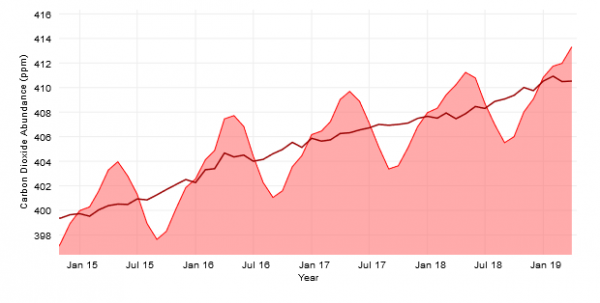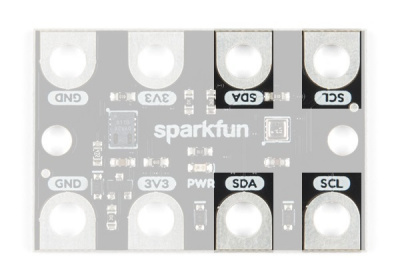SparkFun gator:environment Hookup Guide
Hardware Overview
The gator:environment consists of 4 pads for power and data.
| Contacts | Direction | Description |
|---|---|---|
| GND | N/A | Ground: Reference voltage and ground loop. |
| 3.3V | In | Power: Provides 3.3V to board. |
| SDA | Bi-directional | Data: Data and commands are transmitted between the sensor and microcontroller. |
| SCL | In | Clock: The microcontroller provides the timing needed to communicate on the data line. |
Power
The specified operating voltage for the BME280 is between 1.71V - 3.6V and 1.8V - 3.6V for the CCS811. For use with the gator:bit (v2) and micro:bit, you should provide 3.3V through the 3V3 and GND pads to keep the logic levels consistent; the 3.3V input is then regulated to 3.1V for the sensors.
On average, both sensors will consume about 5 mA of current, with a maximum of 13 mA.
BM280
The BME280 is a combined digital humidity, pressure, and temperature sensor that communicates over an I2C bus. For the most part, users will only need to know I2C addresses to prevent address conflicts with other devices or sensors.
Here are some of the characteristics of the BME280 sensor from the datasheet:
| Characteristic | Range |
|---|---|
| Operating Voltage | 1.71V to 3.6V |
| Supply Current | < 714 µA |
| Humidity |
Range: 0 to 100% RH Resolution: .008% RH Absolute Accuracy Tolerance: ±3% from 20 - 80% |
| Temperature |
Range: -40°C to 85°C Absolute Accuracy: ±(0.5 - 1.25) °C Resolution: 0.01 °C |
| Pressure |
Range: 300 to 1100 hPa (30,000 - 110,000 Pa or approx. 4.35 - 15.95 Psi) Absolute Accuracy: ±(1 - 1.7) hPa Relative Accuracy: ±0.12 hPa Maximum Resolution: 0.18 Pa |
| I2C Address | 0x77 (HEX) |
What is Humidity?
Humidity is a measurement of the amount of water vapor in the air. A simple demonstration of humidity is when you breathe on a cold piece of glass, the water vapor from your breath condenses into beads of liquid water. The humidity measurement from the BME280 is reported in terms of relative humidity. Humidity is often associated with various topics in science. For example:
- Humidity affects your body's ability to regulate temperature through perspiration.
- In civil engineering, humidity affects how concrete cures and contributes to the overall strength.
- In various climates, humidity can factor into conditions like precipitation or fog for meteorological reports.
What is Temperature?
Temperature for the most part is the quantification of how hot or cold something is. The BME280 measures the ambient temperature (or temperature of the relative environment). Temperature is reported in different scales or units, the BME280 measures temperature in degrees Celsius. Temperature is an essential unit of measurement that affects all aspects of physical science1. Some applications of the BME280 for temperature are:
- Measurements of the ambient temperature for weather meters.
- Replicating the original Joule experiment for measuring a calorie (waterproofing required).
- Measuring solar radiation as used by solar water heaters.
What is Pressure?
The BME280 measures pressure, specifically atmospheric or barometric pressure. Pressure is usually described as the perpendicular force applied to the surface of an object per unit area; in fluid mechanics, it is also referred to as the compressive stress at a particular point. The BME280 reports pressure units in Pascals. Pressure measurements are useful in a variety of applications:
- Experiments relating to the Ideal Gas Law or related principles.
- Altimeter: Used to determine (pressure) altitude of above a fixed level, which is based on the Barometric formula.
- Atmospheric pressure has a direct relation to wind and local weather.
CCS811
The CCS811 is a digital metal oxide (MOX) gas sensor that detects wide range of Volatile Organic Compounds (VOCs). With an integrated microcontroller that implements special algorithms to process the raw measurements, the CCS811 outputs the equivalent total VOC (eTVOC) and equivalent CO2 (eCO2) values over an I2C connection. For the most part users will only need to know I2C addresses to prevent address conflicts with other devices or sensors.
Here are some of the characteristics of the CCS811 sensor from the datasheet:
| Characteristic | Range |
|---|---|
| Operating Voltage | 1.8V to 3.6V |
| Operational Environment |
Temperature: -5 to 50°C Humidity: 10 to 95% RH |
| Supply Current | 30 mA (average) |
| Equivalent Total VOCs (eTVOC) | 0 - 32768 ppb (parts per billion) |
| Equivalent CO2 (eCO2) | 400 - 29206 ppm (parts per million) |
| I2C Address | 0x5B (HEX) |
- The CCS811 implements a highly reliable micro-hotplate for the gas sensor. However, the performance in terms of resistance levels and sensitivities varies in the early stages. Therefore, AMS recommends that you run (or burn-in) this sensor for 48 hours on your first use. After the burn-in conditioning, a run-in period is required after long idle periods. The run-in time for the CCS811 is 20 minutes, before sensor stabilizes and accurate readings are generated.
(*Essentially, run the board by taking readings for 48 hours the first time you use it to burn-in the sensor. Additionally, after extended periods between uses, you may also need to run the sensor for 20 minutes to stabilize the outputs due to the run-in period.) - To help with the sensor accuracy, the BME280 is also used to provide temperature and humidity compensation. Therefore, any discrepancies between the BME280 readings and the conditions of the ambient air will produce imprecise results. A good example of this is if the board is heated above the temperature of the ambient air; the heating would offset the BME280 and result in inaccurate measurements.
- A baseline correction it is maintained on-the-fly in software, which is enabled automatically after initial device operation. There is the capability for manual correction, but it has not been implemented to simplify the sensor operation.
Equivalent TVOC: What are Volatile Organic Compounds?
MOX sensors are a great method for volatile organic compound (VOC) detection. VOCs are organic chemicals, usually with a high vapor pressure or high volatity, due to their low boiling point at room temperature. For indoor air quality (IAQ), these compounds are often attributed to health effects from mild irritation in brief exposures to more serious health risks with compounding long-term exposure.
Here is a list of VOCs detected by the CCS811:
- Alcohols
- Aldehydes
- Ketones
- Organic Acids
- Amines
- Aliphatic and Aromatic Hydrocarbons
For more information about VOC and their effects on IAQ, check out these resources.
- Volatile Organic Compounds' Impact on Indoor Air Quality
- Fact Sheet: Total Volatile Organic Compounds
- ECA Report No. 19: Total Volatile Organic Compounds (TVOC) in Indoor Air Quality Investigations
Here are some ideas for experiments involving VOCs:
- TeachEngineering: I've Gotta Get Some Air
- Sensing Air Pollution (Safety: adult supervision and open air environment required)
- VOC emission experiments in nature and lab
Note: Unfortunately, the standards associating specific chemical compounds and their health effects are wide and varied. Additionally, the number of VOCs are so numerous that it is impossible for a single sensor to detect each compound. Most sensors, like the CCS811, target specific VOCs and then use algorithms to estimate an equivalent total volatile organic compound (eTVOC) values. This sensor is valuable in providing information for the presence of contaminants in indoor air, but it is trend data and not recommended for exact measurements of VOCs.
[Source- Guidelines for CO2 Sensor Selection]
Equivalent CO2: What is Carbon Dioxide?
Carbon Dioxide (CO2) is a trace gas in Earth's atmosphere and it is a naturally occurring due to its solubility and dissolution in water. CO2 is also a common byproduct of combustion, aerobic, and decomposition reactions. It is highly versatile and extensively used in multiple industrial applications.
A common topic about CO2 is its growing abundance in Earth's atmosphere and the affect that has on climate change, as a greenhouse gas. The Scripps Institution of Oceanography at UC San Diego, has maintained continuous measurements of the accumulation of atmospheric carbon dioxide since 1958. A graph based on those measurements, taken from the Mauna Loa Observatory in Hawaii, is referred to as the Kneeling curve (named after Charles David Keeling).
Here are resources to some simple experiments involving carbon dioxide:
For more information on carbon dioxide concentration levels in the atmosphere, check out these resources:
- Scripps CO2 Program:
- Related News Articles:
Note: Unfortunately, CO2 isn't a VOC and MOX type of sensors can't directly measure CO2, despite being great at VOC detection. However, in an indoor setting, humans are a primary source of VOCs through the process of breathing. The equivalent CO2 (eCO2) values are then estimated based on algorithms that are used to analyze the sensor data to determine the TVOC attributed by the presence of humans. This type of sensor should not be used in applications that directly requires the measurement of CO2; it is an inferred value.
[Source- Guidelines for CO2 Sensor Selection]
I2C Connection
I2C is a communication protocol used to transfer data between master and slave devices. It is a 2-wire connection consisting of SDA (data) and SCL (clock). The protocol is pretty well defined so it can be shared with multiple devices. This is beneficial for daisy chaining multiple devices together on a single bus. The primary thing users will need to watch out for is address conflicts (you can't have devices with the same address).




